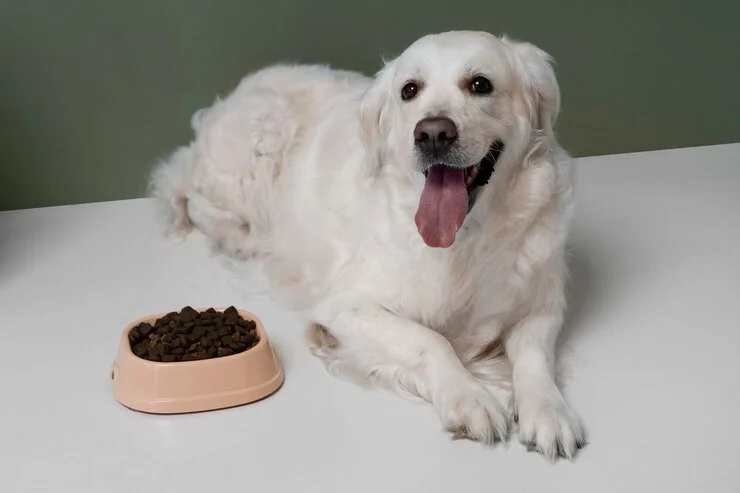Choosing the right dog food can feel confusing. There are so many brands, all claiming to be the best for your dog. There are many options, it’s easy to feel overwhelmed. In this blog, we will discuss how to choose the right dog food.
Have you ever noticed how your dog’s ears perk up at the sound of a food bag crinkling? Dogs love to eat, but did you know that their diet is just as important as their daily walk or favorite belly rub? Good nutrition can affect your dog’s energy, coat, immune system, and even their risk of getting sick.

How to Choose the Right Dog Food
Understanding Your Dog’s Needs
Just like people, dogs need different types of food depending on their age, lifestyle, and any special quirks they have. Let’s look at some important things to think about when picking the best food for your dog:
Age
Puppies: Think of puppies like tiny athletes! They need lots of protein (about 22.5% or more) to help their bones and muscles grow strong. Calcium is also important for their bones and teeth.
Adult Dogs: When your dog is fully grown (usually around 1-2 years old), their food needs change. They need a balanced diet that gives them enough energy, whether they like to chill on the couch or play frisbee. Most adult dog foods have about 18% protein.
Senior Dogs: As dogs get older, their bodies don’t use nutrients as well. Senior dog food is usually easier to digest and may have less protein and fat to help manage their weight and keep their joints healthy.
Breed
Different dog breeds have different needs:
- Large Breeds: Big dogs like Great Danes need food that helps their bones grow strong.
- Working Dogs: Dogs like Border Collies burn a lot of energy, so they need food with more calories and protein.
- Short-Nosed Breeds: Dogs like Pugs have trouble breathing, so their food might be shaped differently to help them eat more easily.
Activity Level
Active dogs need more calories than dogs who lounge around.
- High-Energy Dogs: Dogs that love long walks and playtime need more calories and protein to keep them going.
- Less Active Dogs: Dogs that don’t move around much need food with fewer calories to avoid gaining too much weight.
Health Considerations
Many dogs have allergies or sensitivities to certain ingredients. This can cause itchy skin or stomach problems.
- Allergies: If your dog has allergies, your vet can help find the right food.
- Health Issues: Dogs with health problems might need special food. Always talk to your vet before changing your dog’s diet, especially if they have health concerns.
A survey conducted in the US found that 61% of pet owners associate probiotics in pet food with digestive health.
By thinking about these factors, you can choose the best food to keep your dog happy and healthy.
Recommendation: How To Transport Pets In India
Dog Food Labels
Dog food labels can look complicated with lots of words and numbers, but don’t worry! Here’s an easy guide to help you understand them:
The AAFCO Seal of Approval
Look for a statement from the Association of American Feed Control Officials (AAFCO) on the label. This means the food meets certain standards and is balanced for your dog. It’s like a thumbs-up from dog nutrition experts!
Ingredient List
This part is important! Ingredients are listed by weight, so the first ingredient is the main one. Look for whole meat sources like chicken, fish, or beef at the top of the list. These are good for your dog’s muscles and energy. Meat meals (like chicken meal) are also okay—they just have most of the water taken out. Avoid foods with vague terms like “meat by-products” because you don’t know what parts of the animal they include.
Nutritional Breakdown
This section shows the amounts of protein, fat, fiber, vitamins, and minerals in the food. Protein and fat are very important for your dog’s health. Puppies need more protein (around 22.5% or higher) compared to adult dogs (around 18%). The fat content will depend on your dog’s age and activity level.
Marketing Buzzwords
Don’t be fooled by fancy words like “grain-free” or “holistic.” These don’t always mean the food is better. Grains can be a good source of energy for dogs, and “holistic” doesn’t have a specific definition. If you’re not sure about something, it’s always best to ask your veterinarian for advice on the best food for your dog.
A survey by the research firm Mordor Intelligence revealed that 39% of US pet food product launches in 2022 had “digestive health” claims. This highlights a trend towards pet owners seeking premium pet food options that prioritize specific health benefits.

Choosing the Right Food Type: Dry, Wet, or Raw?
Now that you know how to read dog food labels, let’s talk about the different types of dog food available.
Kibble (Dry Food) The most common type of dog food is kibble (dry food). It’s convenient, easy to store, and affordable. Crunching on kibble can also help keep your dog’s teeth clean. However, some picky pups might find it boring, and it doesn’t have as much moisture as other options.
Wet Food is like yummy canned dog stew! It has a higher moisture content than kibble, which is great for picky eaters or dogs who need extra hydration. The downside is that wet food can spoil faster than kibble and is generally more expensive.
Raw Food Diets try to mimic what dogs would eat in the wild, with raw meat, bones, and vegetables. While it might seem like the most natural option, raw food diets require a lot of research and planning to ensure your dog gets all the nutrients they need. There’s also a risk of bacterial contamination if not handled properly. Always talk to your veterinarian before switching your dog to a raw food diet.
Making the Transition to a New Food
So, you’ve found the perfect food for your furry friend – yay! But before you switch their food completely, there’s an important step: a slow transition.
Just like people, dogs can get tummy aches if their food changes too fast. To avoid any upset stomachs, here’s what you can do over 7-10 days:
Start Small: Mix a tiny bit of the new food with your dog’s regular food for the first few days. Just a spoonful in their bowl to start.
Gradually Increase: Every day, give them a little more new food and a little less of the old food.
Watch Your Pup: Keep an eye on your dog during this time. Are they pooping normally? Do they seem as energetic as usual? Is their fur looking okay? If you see any signs of tummy troubles, slow down the transition or talk to your vet.
By going slow, you can help your dog’s tummy get used to the new food without any problems. Before you know it, they’ll be happily munching on their new chow with a wagging tail and a happy belly!
Conclusion
Picking the right food for your dog doesn’t have to be hard! By thinking about your dog’s age, breed, activity level, and any health issues, you can find the perfect food to keep them happy and healthy. Look for the AAFCO statement on the bag – it’s your guide to a complete and balanced diet. Check the ingredient list to see what’s really inside. Don’t be fooled by fancy marketing words – talk to your vet for advice that’s best for your dog.
Whether you go with dry kibble for convenience, wet food for extra moisture, or consider a raw diet with your vet, make sure to switch foods slowly to avoid tummy problems.
With the right food and lots of love, your dog will stay by your side, wagging their tail and ready for adventures!
Resources:
- Association of American Feed Control Officials (AAFCO)
- World Small Animal Veterinary Association (WSAVA) (Provides resources on pet nutrition)
- American Veterinary Medical Association (AVMA) (Offers guidance on pet health and nutrition)
FAQs
How can I find the right food for my dog?
To find the right food for your dog, consider their age, breed, size, activity level, and any health issues they might have. Puppies, adult dogs, and senior dogs have different nutritional needs. It’s important to choose food that matches your dog’s specific requirements. Consult your veterinarian for personalized advice and check for the AAFCO seal of approval on dog food labels to ensure the food is balanced and complete.
What is the healthiest food to feed your dog?
The healthiest food for your dog is one that provides balanced nutrition tailored to their age, breed, and activity level. High-quality commercial dog foods that list whole meats and have an AAFCO statement are generally good choices. Some dog owners also opt for homemade or raw diets, but these require careful planning to ensure they meet all nutritional needs. Always consult your veterinarian before making significant changes to your dog’s diet.
What to avoid when choosing dog food?
Avoid dog foods with vague ingredients like “meat by-products,” as these can include low-quality parts of animals. Steer clear of foods with artificial colors, flavors, and preservatives, which can cause health issues over time. Also, be wary of marketing buzzwords like “grain-free” or “holistic” without checking if they truly benefit your dog’s health.
What to consider when choosing dog food?
When choosing dog food, look at the ingredient list and ensure whole meat like chicken, fish, or beef is listed first. Check the nutritional breakdown to see if the protein, fat, and other nutrients match your dog’s needs. Also, consider your dog’s age, breed, and activity level. Look for the AAFCO statement on the label to ensure the food meets nutritional standards.
Can dogs eat rice?
Yes, dogs can eat rice. Rice is often included in commercial dog foods and can be a good source of carbohydrates for energy. Plain, cooked rice can also be a soothing food for dogs with upset stomachs. However, it should be given in moderation and as part of a balanced diet.
What is the perfect meal for a dog?
The perfect meal for a dog is one that provides all the essential nutrients they need for their age, size, breed, and activity level. This typically includes a good source of protein (like chicken, beef, or fish), healthy fats, carbohydrates, vitamins, and minerals. High-quality commercial dog foods are formulated to be balanced and complete, but you can also create a homemade diet with the help of your veterinarian to ensure it meets all of your dog’s nutritional needs.